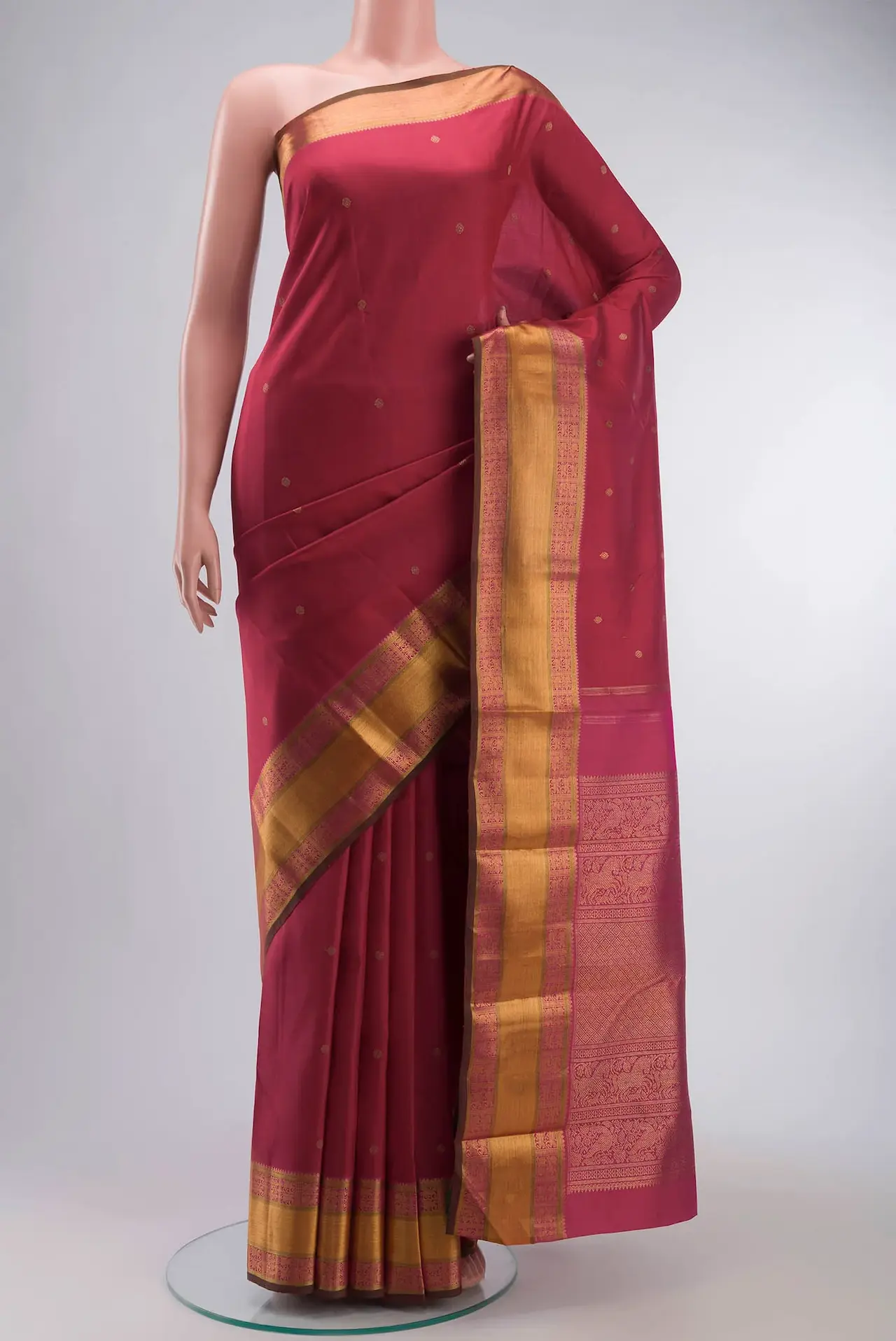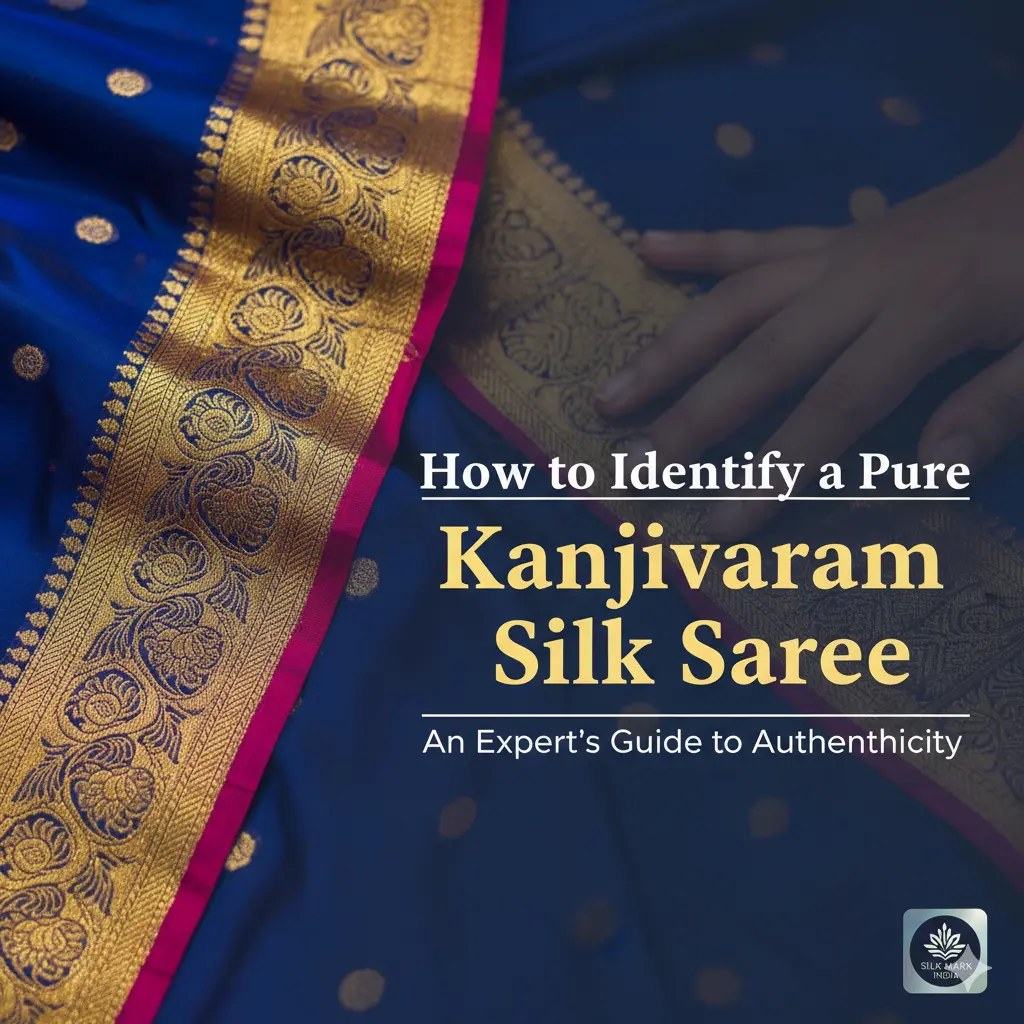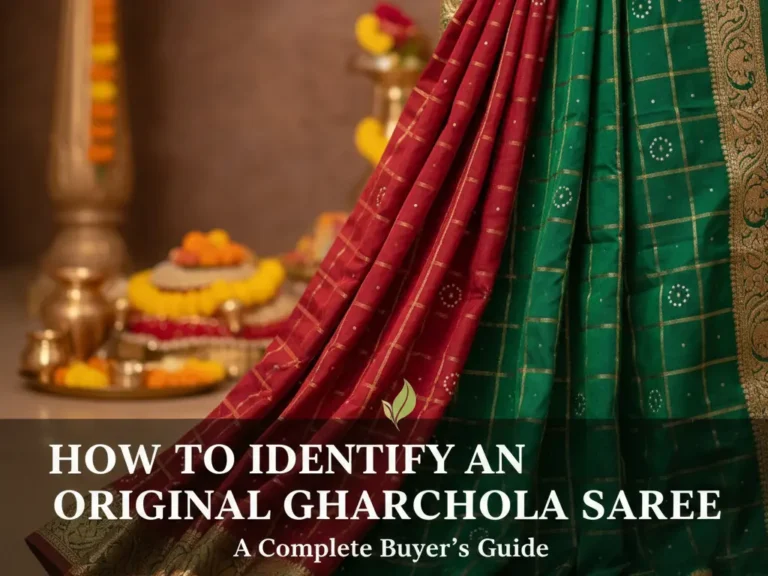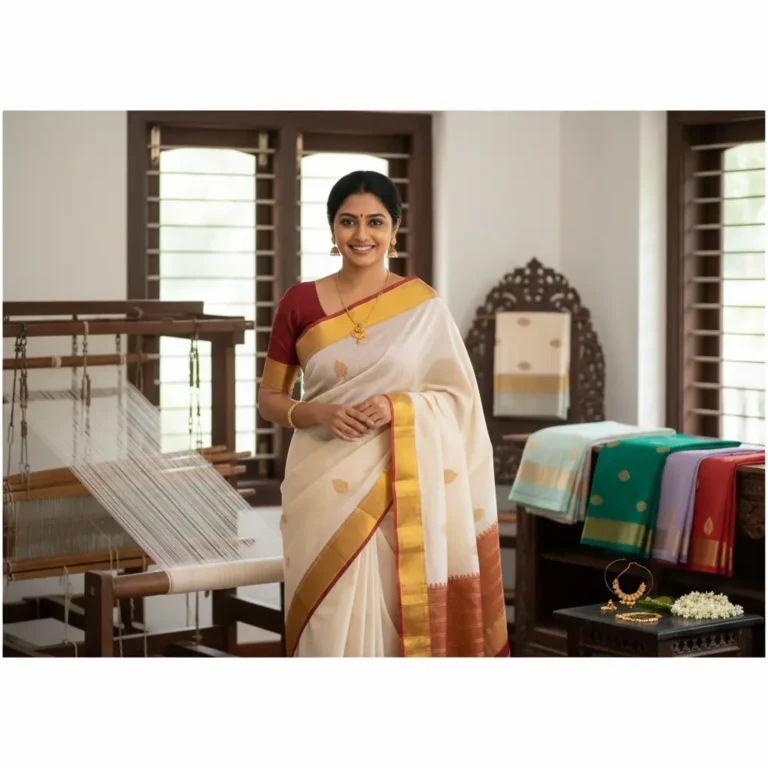A pure Kanjivaram silk saree is more than a beautiful garment. It is a symbol of heritage, celebration, and pride for Indian women, especially brides. For many families, buying a Kanjivaram is an emotional investment because the saree becomes a treasured heirloom. Therefore, it is important to learn how to identify a pure Kanjivaram silk saree, as the market is now filled with machine-made imitations that look similar but lack authenticity and long-lasting value.
Kanjivaram sarees are known for three core elements: pure mulberry silk, real zari, and the traditional handwoven weave. When these components are genuine, the saree becomes strong, luxurious, and timeless. However, many buyers still struggle to differentiate between an original and a fake piece.
The Non-Negotiable First Step: Always Check for the Silk Mark
The simplest and most reliable way to confirm authenticity is to check whether the saree has a Silk Mark. The Silk Mark is issued by the Silk Mark Organisation of India (SMOI), which is the government-approved body that certifies genuine silk products. Every kanchipuram silk saree with Silk Mark carries a unique hologram and serial number that cannot be duplicated easily.
The Silk Mark tag is usually attached to the pallu or border. It confirms that the yarn used is pure mulberry silk. Moreover, the certification provides a basic level of trust because only registered manufacturers and weavers can obtain it.
While the Silk Mark is not a guarantee of craftsmanship quality, it is the most important first filter. Therefore, if a seller avoids showing the tag or claims it was removed, you should be cautious. An authentic Kanjivaram saree will always come with a Silk Mark certificate or sticker.
ALSO Read: How to Identify an Original Gharchola Saree
Testing the Zari: The True Measure of Value
1. How to Check the Purity of Zari in a Kanjivaram Saree
Zari is what gives a Kanjivaram its glow and richness. True Kanjivaram zari is made of silk thread wrapped with silver, which is then dipped in gold. Because the metal content is real, pure zari makes the saree heavier and more durable. It also ages beautifully, gaining a classic patina.
However, fake zari—made from plastic or polyester—looks bright but feels cheap. The good news is that buyers can perform a simple pure zari test at home to check the difference.
First, look closely at the border and pallu. Pure zari has a subtle shine, not a loud, metallic glare. In addition, the border feels dense due to the weight of real zari. Therefore, if a border feels extremely light, you should investigate further.
2. The Scratch Test: A Simple On-the-Spot Zari Check
The scratch test is a trusted traditional method used by weavers. Take a loose thread from the backside of the border or pallu. Gently scratch it with your fingernail. If the zari is pure, the outer golden layer will peel slightly to reveal a reddish silk thread inside. This confirms that the thread is real and has been wrapped with silver and gold.
However, fake zari behaves differently. When scratched, it often flakes like cheap foil and reveals a white polyester or plastic thread. This is the quickest kanjivaram silk saree authenticity test you can perform without damaging the saree.
3. Zari Appearance and Weight: Visual and Tactile Clues
Weight is an important indicator. Pure zari adds noticeable heaviness to the saree, especially in the border and pallu. When you drape or lift the saree, the fall should feel rich and full-bodied. In contrast, fake zari is extremely light because synthetic threads weigh almost nothing.
Moreover, pure zari has a warm, gentle glow. It never looks overly shiny or mirror-like. Fake zari, however, can appear harsh, bright, and yellowish. These visual clues help you compare options side by side, making identification easier.

Examining the Fabric and Weave
1. The Touch Test: Feeling for Pure Kanjivaram Silk
The fabric of a pure Kanjivaram saree is unmistakable. It feels firm, crisp, and heavy but still soft to the touch. This unique texture comes from double-weft weaving using 3-ply pure mulberry silk. Therefore, when you hold a pure Kanjivaram, it has weight and structure.
Imitation sarees feel different. Some are too smooth and slippery because they use artificial silk or polyester blends. Others feel thin and lifeless because they lack the richness of mulberry silk. When comparing the difference between pure and fake Kanjivaram, the touch test often makes the result clear within seconds.
2. Understanding Korvai: The Signature Weaving Technique
One of the strongest identity markers of a true Kanjivaram saree is the Korvai weaving technique. In Korvai, the body, border, and pallu are woven separately. They are then interlocked manually using a secure, zig-zag joining method. Because the process is labor-intensive, only handlooms can produce authentic Korvai.
To identify Korvai, turn the saree to the reverse side and inspect the line where the body meets the border. You should see a clear zig-zag interlock that feels sturdy and visible.
This interlocking pattern is a signature of traditional craftsmanship. Machine-made sarees usually show a straight, uniform joint without any handwoven irregularities.
3. The Reverse Side Inspection
The reverse side of a pure Kanjivaram tells its own story. Because it is handwoven, the backside will show neat threads, floats, and weft lines. The motifs on the front and back align beautifully. Moreover, natural imperfections—tiny missing threads or irregularities—are signs of handloom authenticity.
In contrast, fake sarees often have printed motifs, machine-finished backs, or glued zari designs. These are clear indicators that the saree is not a pure Kanjivaram.
Advanced Verification & Final Checks
1. The Burn Test: For Experts Only (and Why It Works)
The burn test for pure silk saree is highly accurate but also destructive, so it must be done with caution. Take a tiny loose thread from the inner corner. Carefully burn it using a matchstick.
Pure silk burns slowly and smells like burnt hair. It leaves behind fine, powdery black ash. However, artificial silk melts quickly, smells like burning plastic, and leaves a hard bead-like residue.
Because this test can damage the saree, it should be used only when necessary and ideally under expert supervision.
2. Color Contrast and Motifs: The Traditional DNA
Authentic Kanjivaram sarees are known for their bold and classic color combinations. Deep jewel tones such as maroon, mustard, bottle green, and royal blue often combine with gold zari borders. This contrast is a design signature.
Motifs also offer clues. Traditional designs include peacocks (mayil), yali, mango, temple borders, chakrams, and rudraksha patterns. Since Kanjivaram art is inspired by South Indian temples and mythology, these motifs repeat across generations.
If a saree features modern digital prints or unusual motifs, it may not be a pure traditional Kanjivaram.
3. Price and Trust: The Reality Check
A pure Kanjivaram cannot be cheap. The cost of pure mulberry silk, genuine zari, and weeks of handloom labor makes each saree valuable. Therefore, if the price seems too low, it is most likely a fake.
Always purchase from trusted weavers, certified emporiums, or well-reviewed stores. Authentic sellers also provide the Silk Mark certificate, invoice, and product details without hesitation.
Conclusion:
A pure Kanjivaram silk saree is a masterpiece of tradition and craftsmanship. To identify one, always begin with the Silk Mark, check the zari through the scratch test, and inspect the Korvai weave. These three elements alone can protect you from most counterfeit products. With the right knowledge, you can confidently choose a saree that carries cultural value, lasting quality, and true beauty.
Thank you for reading! If you found this article helpful, please share it within your community or groups, leave a comment with your feedback and don’t forget to visit Abmantra for more informative blogs on Women fashion and beyond.
ALSO Read About: Haradhi Sarees & Khadi Cotton Sarees
FAQs:
How to check original Kanjivaram saree?
Start by checking the Silk Mark certification. Then examine the zari using the scratch test, inspect the Korvai interlock, and evaluate the fabric weight and texture.
What is pure Kanjivaram silk?
Pure Kanjivaram silk is made from high-quality mulberry silk woven in Kanchipuram. It uses pure zari and traditional handloom techniques to create a rich and durable saree.
What is the real Kanjivaram zari made of?
Authentic zari is made of silk thread wrapped with silver and then dipped in gold. This makes the saree heavier and more luxurious.
Why are Kanjivaram sarees so expensive?
They are expensive because they use pure mulberry silk, real zari, and time-intensive hand-weaving methods like Korvai. Each saree can take weeks to complete.
What is the Korvai technique in Kanjivaram sarees?
Korvai is a traditional interlocking method that joins the separately woven body and border. It creates a strong zig-zag interlock visible on the reverse side.

This article has been written by the AB Mantra Team, a group of passionate writers and researchers covering topics across fashion, travel, finance, health, education, technology, lifestyle and business. Our goal is to share accurate, easy-to-understand, and helpful information that adds real value to readers. Each piece is carefully reviewed to maintain clarity, reliability and trust.




